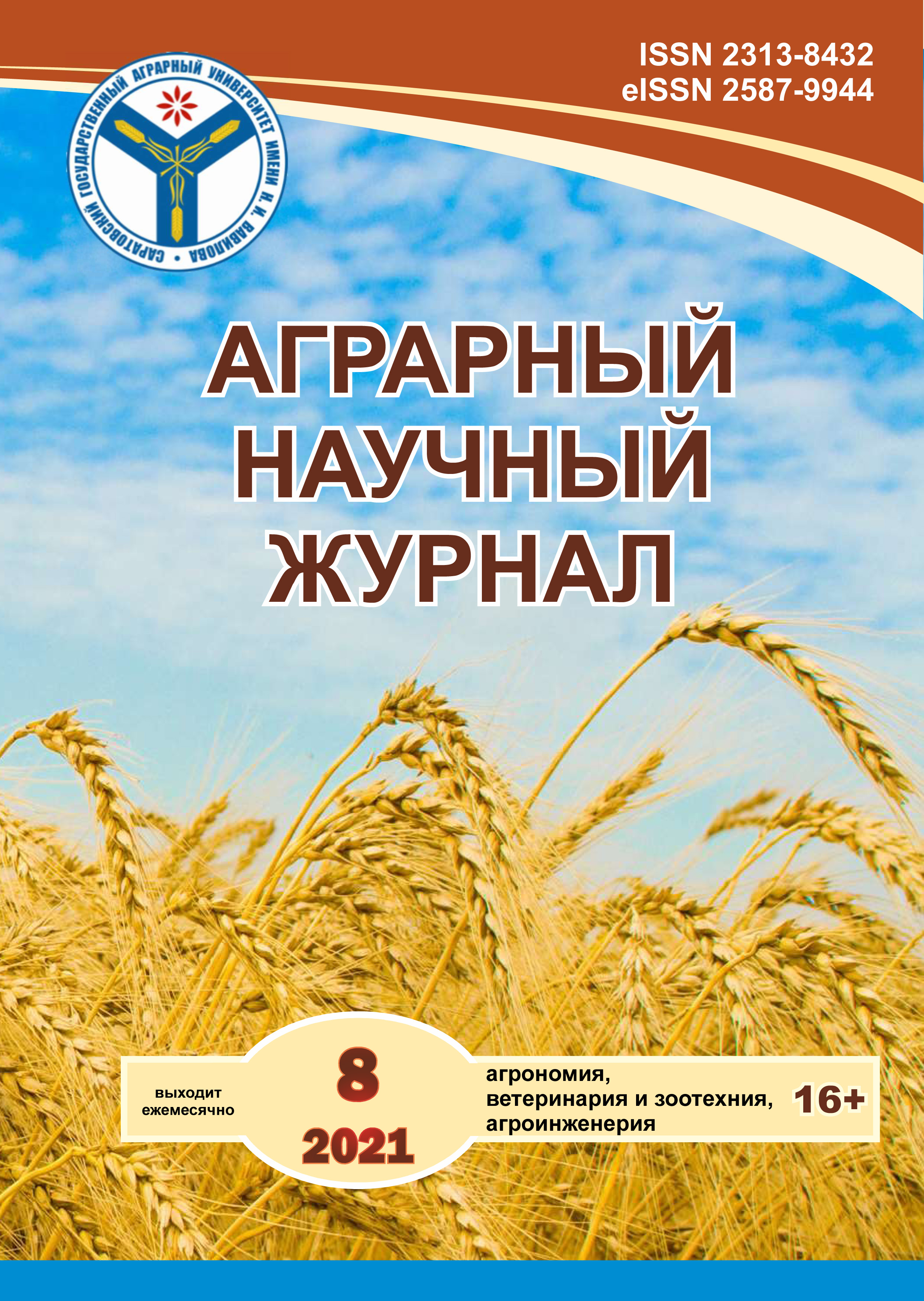The role of dietary supplements in the meat productivity of rabbits with a dry type of feeding
DOI:
https://doi.org/10.28983/asj.y2021i8pp67-70Keywords:
young rabbits, vitamin-mineral premix, nanocrystalline iron, slaughter yield, feed conversion rateAbstract
The role of vitamin-mineral premix and nanocrystalline iron in the meat productivity of young rabbits was studied by classical methods in the scientific and economic experience in the departments of fur farming and Rabbit Breeding of the V. A. Afanasyev Research Institute of Fur Farming and Rabbit Breeding. From 180 heads of young rabbits at the age of 45 days, 3 groups of 60 heads each were formed according to the principle of analogues: the 1-st-control group received a typical full-fledged granulated mixed feed (FGMF) with a vitamin-mineral premix P 90-2T, in the (FGMF) of the 2-nd and 3-rd experimental groups, the premix was absent, but nanocrystalline iron was included in the (FGMF) of the 3-rd group. Control slaughter of rabbits to assess meat productivity was carried out at the age of 90 days. During the experiment, it was found that the feed in all groups was identical in gross caloric content, but slightly different in the ratio of nutrients. In the mixed feed of the experimental groups, there were more nutrients with the highest digestibility coefficient (fat and soluble carbohydrates) and almost 2 times less fiber, which is slightly digested in young rabbits, only by 3-10%. Rabbits of all groups had no significant differences in live weight and average daily gain. But during the fattening period, the rabbits of the experimental groups consumed less feed when feeding freely than in the control group. At the same time, there were no significant differences in the mass of the carcass and the slaughter yield between the groups. But the feed conversion rate in the experimental groups was 1.32 and 1.28 lower than in the control group, which is economically advantageous. Based on the results of the experiment, it can be assumed that the inclusion of biologically active additives in the form of vitamin-mineral premix and nanocrystalline iron in the full-fledged granular feed for young rabbits does not make much sense, since it does not contribute to increasing meat productivity. In the cost of mixed feed, the vitamin and mineral premix accounts for 10%. Optimizing the ratio of nutrients in the diet plays a crucial role in reducing the feed conversion rate.
Downloads
References
Биологическая активность нанокристаллического железа при скармливании кроликам и обработке семян растений / А.А. Назарова [и др.] // Кролиководство и звероводство. – 2008. – № 6. – С. 8–10.
Велькина Л.В. Мировые тенденции развития кролиководства // Экомика сельского хозяйства России. – 2019. – № 3. – С. 93–98.
Зоотехнический анализ кормов / Е.В. Петухова [и др.]. – М.: Колос, 1981. – 256 с.
Комлацкий В.И., Цыганок Л.Э., Туркова В.С. Развитие индустриального кролиководства на Кубани // Кролиководство и звероводство. – 2019. – № 5. – С. 8–15.
Куликов Н.Е. Коррекция питательности полнорационных комби-кормов для кроликов премиксами // Кролиководство звероводство. – 2017. – № 3. – С. 39–44.
Лактионов К.С., Зуенко В.А. Физиология пищеварения кроликов. – Орел, 2016. – 194 с.
Люднов И.П., Квартникова Е.Г. Влияние сернокислых солей железа и меди на интенсивность роста молодняка кроликов / Научные основы и обеспечение качества биологических препаратов АПК: материалы Междунар. науч.-практ. конф., посвящ. 100-летию Орловской биофабрики. – Орел, 2018. – С. 114–118.
Нигматуллин Р.М., Балакирев Н.А. Разведение и селекционно-племенная работа в кролиководстве. – М.: Научная библиотека, 2020. – 514 с.
Новое в кормлении животных. Справочное пособие / Под общ. ред. В.И. Фисинина [и др.]. – М.: Изд-во РГАУ – МСХА, 2012. – 788 с.
Нормы и рационы сельскохозяйственных животных. Справочное пособие. – 3-е изд., перераб. и доп. / под ред. А.П. Калашникова [и др.]. – М., 2003. – 456 с.
Нормы кормления и нормативы затрат кормов для пушных зверей и кроликов. Справочное пособие / Под ред. Н.А. Балакирева, В.Ф. Кладовщикова. – М., 2007. – 185 с.
Основные болезни кроликов / К.В. Харламов [и др.]. – М.: ЗооВе-тКнига, 2014. – 166 с.
Переваримость питательных веществ полнорационного гранулиро-ванного комбикорма (ПГК) молодняком кроликов в динамике / Е.Г. Квартни-кова [и др.] // Кролиководство и звероводство. – 2019. – № 1. – С. 15–18.
Соболев А.Д. Основы вариационной статистики. – М., 2003. – 100 с.
Степень влияния синтетических витаминов и микроэлементов на мясную продуктивность молодняка кроликов / М.П. Квартников [и др.] // Кро-лиководство и звероводство. – 2020. – № 1. – С. 14–20.
Харламов К.В., Куликов Н.Е. Кролик – совершенная биосистема // Кролиководство и звероводство. – 2015. – № 2. – С. 24–29.
Gutierrez I., Espinosa A., Garcia J., Carabano R., De Blas J.C. Effect of levels of starch, fiber and lactose on digestion and growth performance of early-weaned rabbits // J. Anim. Sci., 2002, 80: 1029–1037.
De Blas C., Wiseman J. et al. Nutrition of the rabbit. 2nd ed. CAB In-ternational, Nallingford. 2010.
Lebas F. Reflection on rabbit nutrition with special emphasis on fid in-gredients utilization Proc. 8th Word Rabbit Congress. Puebla. Mexico, 2004: 686 – 736.
Molina E., Gonzalez-Redondo P., Moreno-Rojas R., Montero-Quintero K., Bracho B., Sanchez-Urdaneta A. Effects of diets with Amaranthus dubius Mart. ex Thell. on performance and digestibility of growing rabbits // World Rabbit Sci., 2015, 23: 9–18.
Downloads
Published
Issue
Section
License
Copyright (c) 2021 The Agrarian Scientific Journal

This work is licensed under a Creative Commons Attribution-NonCommercial 4.0 International License.








